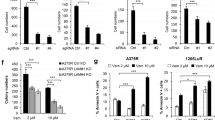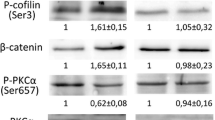Abstract
Ectopic expression of MCAM/MUC18, a cell adhesion molecule in the immunoglobulin-like gene superfamily, induces two moMCAM/MUC18-minus, non-metastatic mouse melanoma K1735 sublines, K3 (tumor+/metlow) and K10 (tumor−/metlow), to metastasize to lungs in a syngeneic C3H mouse model. In this report, we extended investigation of effects of moMCAM/MUC18 expression on tumorigenesis and metastasis in another lowly metastatic, however highly tumorigenic moMCAM/MUC18-minus mouse melanoma K1735 subline, K9 (tumor+++/metlow). We transfected this subline with the moMCAM/MUC18 cDNA, selected for G418-resistant clones with different expression levels of moMCAM/MUC18, and used them for testing effects of MCAM/MUC18 expression on in vitro growth rate, motility, and invasiveness, in vivo subcutaneous tumor growth, and pulmonary metastasis in syngeneic C3H brown mice. Similar to K3 and K10 cells, increased expression of MCAM/MUC18 in K9 cells did not significantly affect in vitro growth rate, but increased in vitro motility and invasiveness. Surprisingly, increased expression of MCAM/MUC18 in K9 cells decreased their induction of tumorigenesis and suppressed their establishment of pulmonary nodules in syngeneic C3H brown mice. We concluded that increased MCAM/MUC18 expression in K9 subline increased in vitro epithelial-to-mesenchymal transition; however, it suppressed in vivo tumorigenicity and metastasis. Thus MCAM/MUC18 acts as a tumor and metastasis suppressor for the K9 subline, different from its role in other K1735 sublines, K3 and K10. Different intrinsic co-factors in different K1735 sublines, which modulate the functions of MCAM/MUC18 in the cells that interact differently to the tumor microenvironment, may render sublines manifest differently in tumorigenicity and metastasis in vivo.






Similar content being viewed by others

Abbreviations
- CAM:
-
Cell adhesion molecule
- FBS:
-
Fetal bovine serum
- huMCAM/MUC18:
-
Human MelCAM/MUC18
- Ig-like:
-
Immunoglobulin-like
- K9:
-
Mouse melanoma K1735 subline #9
- moMCAM/MUC18:
-
mouse MelCAM/MUC18
- IV injection:
-
Intravenous injection
- SC injection:
-
Subcutaneous injection
References
Siegel R, Ma J, Zou Z et al (2014) Cancer statistics 2014. CA Cancer J Clin 64(1):9–29
Lehmann JM, Holzmann B, Breitbart EW et al (1987) Discrimination between benign and malignant cells of the melanocytic lineage by two novel antigens, a glycoprotein with a molecular weight of 113,000 and a protein with a molecular weight of 76,000. Cancer Res 47:841–845
Lehmann JM, Reithmuller G, Johnson JP (1989) MUC18, a marker of tumor progression in human melanoma. Proc Natl Acad Sci USA 86:9891–9895
Zigler M, Villares GJ, Dobroff AS et al (2011) Expression of Id-1 is regulated by MCAM/MUC18: a missing link in melanoma progression. Cancer Res 71(10):3494–3504
Xie S, Luca M, Huang S et al (1997) Expression of MCAM/MCU18 by human melanoma cells leads to increased tumor growth and metastasis. Cancer Res 57:2295–2303
Schlagbauer-Wadl H, Jansen B, Muller M et al (1999) Influence of MUC18/MCAM/CD146 expression on human melanoma growth and metastasis in SCID mice. Int J Cancer 81:951–955
Yang H, Wang SW, Liu Z et al (2001) Isolation and characterization of murine MUC18 cDNA gene, and correlation of MUC18 expression in murine melanoma cell lines with metastatic ability. Gene 265:133–145
Wu GJ, Wu MWH, Wang SW et al (2001) Isolation and characterization of the major form of human MUC18 cDNA gene and correlation of MUC18 over-expression in prostate cancer cells and tissues with malignant progression. Gene 279:17–31
Fidler IJ, Gruys E, Cifone MA et al (1981) Demonstration of multiple phenotypic diversity in a murine melanoma of recent origin. J Natl Cancer Inst 67:947–956
Wu GJ, Fu P, Wang SW et al (2008) Enforced expression of MCAM/MUC18 increases in vitro motility and invasiveness and in vivo metastasis of two mouse melanoma K1735 sublines in a syngeneic mouse model. Mol Cancer Res 6(11):1666–1677
Wu GJ, Peng Q, Wang SW et al (2001) Effect of MUC18 expression on the in vitro invasiveness and in vivo tumorigenesis and metastasis of mouse melanoma cell lines in a syngeneic mouse model. The proceedings of the 92nd annual meeting of American Association for the cancer research, vol. 42, pp 516. Abstract # 2776
Ausubel FM, Brent R, Kingston RE et al (1987) Analysis of proteins. Current protocols in molecular biology. Interscience Press, New York, Section 10
Carmichael J, DeGraff WG, Gazdar AF et al (1987) Evaluation of a tetrazolium-based semi-automated colorimetric assay: assessment of chemosensitivity testing. Cancer Res 47(4):936–942
Passaniti A, Isaacs JT, Haney JA et al (1992) Stimulation of human prostatic carcinoma tumor growth in athymic mice and control of migration in culture by extracellular matrix. Int J Cancer 51:318–324
Wu GJ, Wu MWH, Liu Y (2011) Enforced expression of human METCAM/MUC18 increases the tumorigenesis of human prostate cancer cells in nude mice. J Urology 185:1504–1512
Wu GJ, Chang IY (2016) ShRNAs-reduction of endogenous METCAM/MUC18 expression in human prostate cancer cell line DU145 decreases in vivo tumorigenesis in nude mice. (Submitted)
Zeng G, Cai, S, Wu GJ (2011) Up-regulation of METCAM/MUC18 promotes motility, invasion, and tumorigenesis of human breast cancer cells. BMC Cancer 11:113 (30 March 2011) doi:10.1186/1471-2407-11-113
Zeng G, Cai S, Wu GJ (2012) METCAM/MUC18 augments migration, invasion, and tumorigenicity of human breast cancer SK-BR-3 cells. Gene 492:229–238
Liu YC (2014) Putative roles of huMETCAM in modulating the development and progression of nasopharyngeal carcinoma. Thesis of Master Science degree under the supervision of Dr. Guang-Jer Wu, Department of Bioscience Technology, Chung Yuan Christian University, Taiwan. http://www.lib.cycu.edu.tw/thesis
McGary EC, Heimberger A, Mills L et al (2003) A fully human anti-melanoma cellular adhesion molecule/MUC18 antibody inhibits spontaneous pulmonary metastasis of osteosarcoma cells in vivo. Clin Cancer Res 9:6560–6566
Wu GJ, Peng Q, Fu P et al (2004) Ectopical expression of human MUC18 increases metastasis of human prostate cancer LNCaP cells. Gene 327:201–213
Zeng Q, Li W, Lu D et al (2012) CD146, an epithelial-mesenchymal transition inducer, is associated with triple-negative breast cancer. Proc Natl Acad Sci USA 109(4):127–1132
Wu GJ, Zeng G (2016) METCAM/MUC18 is a novel tumor and metastasis suppressor for the human ovarian cancer SKOV3 cells. BMC Cancer 16:136. doi:10.1186/S12885-016-2181-9
Lin JC, Chiang CF, Wang SW et al (2014) Significance and expression of human METCAM/MUC18 in nasopharyngeal carcinoma (NPC) and metastatic lesions. Asian Pac J Cancer Prev 15(1):245–252
Li Q, Yu Y, Bischoff J et al (2003) Differential expression of CD146 in tissues and endothelial cells derived from infantile haemangioma and normal human skin. J Path 201:296–302
Cavallaro U, Christofori G (2005) Cell adhesion and signaling by cadherins and Ig-CAMs in cancer. Nat Rev/Cancer 4:118–132
Wu GJ (2005) METCAM/MUC18 expression and cancer metastasis. Curr Genomics 6:333–349
Aguirre-Chiso JA (2007) Models, mechanisms and clinical evidence for cancer dormancy. Nat Rev/Cancer 7:834–846
Pickl WF, Majdic O, Fischer GF et al (1997) MUC18/MCAM (CD146), an activation antigen of human T lymphocytes. J Immunol 158:2107–2115
Elshai MF, Khan SS, Takahashi Y et al (2005) CD146 (MelCAM), an adhesion marker of endothelial cells, is a novel marker of lymphocyte subset activation in normal peripheral blood. Blood 106(8):2923–2924
Despoix N, Walzer T, Jouve N et al (2008) Mouse CD146/MCAM is a marker of natural killer cell maturation. Eur J Immunol 38:2855–2864
DeNardo DG, Magnus Johansson M, Coussens LM (2008) Immune cells as mediators of solid tumor metastasis. Cancer Metastasis Rev 27:11–18
Leslie MC, Zhao YJ, Lachman LB et al (2007) Immunization against MUC18/MCAM, a novel antigen that drives melanoma invasion and metastasis. Gene Therapy 14:316–323,382
Takahashi Y, Nishikawa M, Takakura Y (2009) Non-viral vector-mediated RNA interference: its gene silencing characteristics and important factors to achieve RNAi-based gene therapy. Adv Drug Deliv Rev 61:760–766
Acknowledgments
I thank Qiong Peng, Pingping Fu and Mei-Whey H. Wu for technical help. This was partly supported by the funds of Emory University Research committee and Emory University Skin disease Research Center and by grants from National Science council), Taiwan (NSC-101-2320-B-033-001 and -003) (GJWu).
Author information
Authors and Affiliations
Corresponding author
Ethics declarations
Conflict of interest
The author declared no conflict of interest.
Rights and permissions
About this article
Cite this article
Wu, GJ. Ectopic expression of MCAM/MUC18 increases in vitro motility and invasiveness, but decreases in vivo tumorigenesis and metastasis of a mouse melanoma K1735-9 subline in a syngeneic mouse model. Clin Exp Metastasis 33, 817–828 (2016). https://doi.org/10.1007/s10585-016-9812-z
Received:
Accepted:
Published:
Issue Date:
DOI: https://doi.org/10.1007/s10585-016-9812-z



